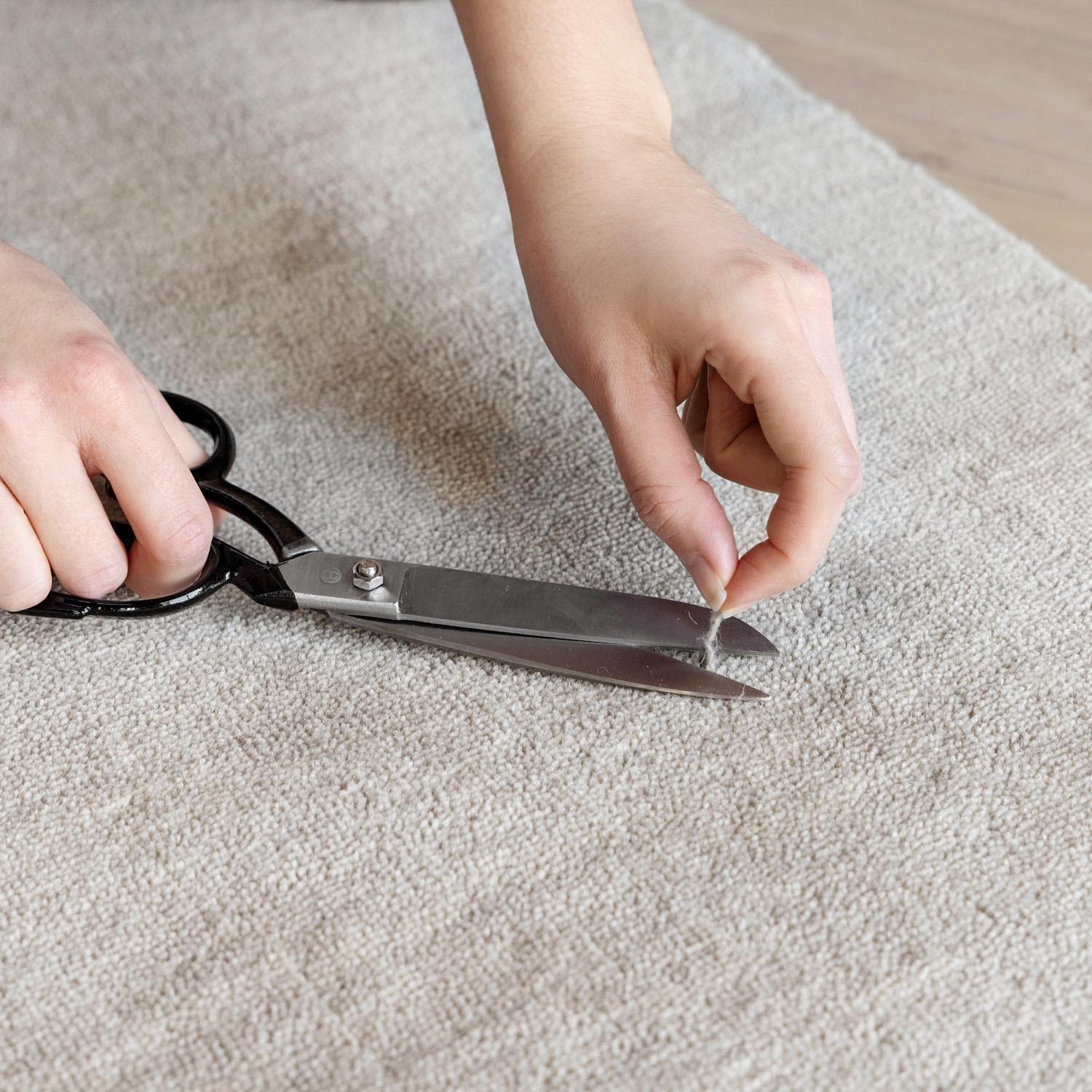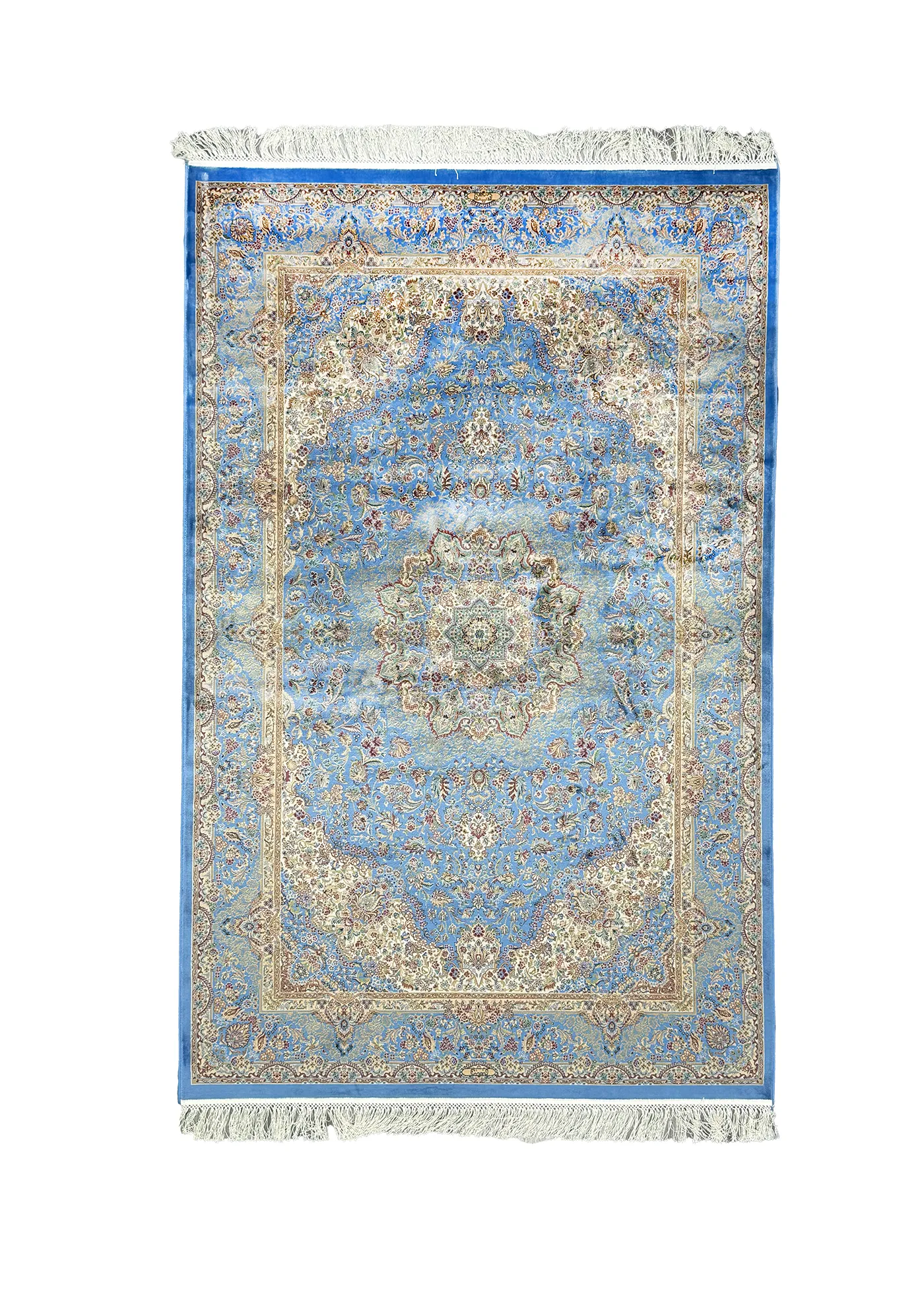How Persian Rugs Are Made: Art and Tradition
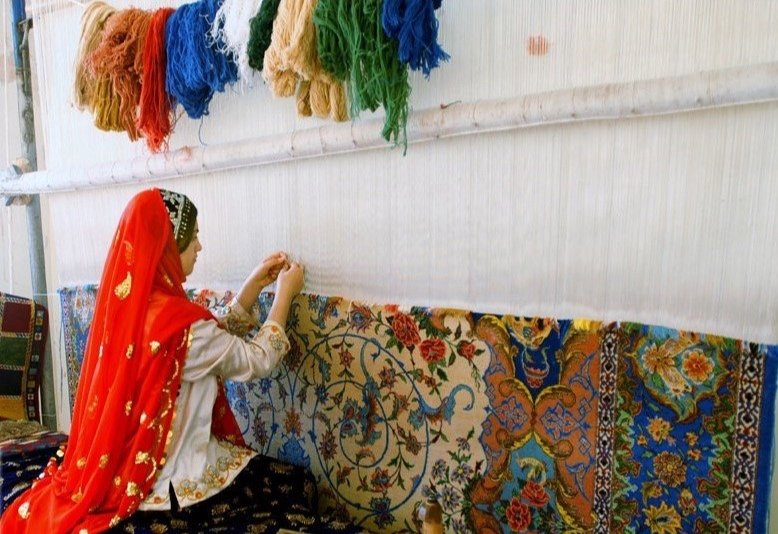
Introduction: How Persian Rugs Are Made?
Have you ever stepped into a space and noticed a Red Persian Rug glowing with floral designs? There’s magic in a Persian Style Rug that turns a room into a story. These rugs aren’t just decor—they’re art pieces woven with centuries of tradition.
In this journey, we’ll explore how artisans make Persian Rugs, from vibrant dyes to final knots. You’ll see why each rug holds a legacy of skill and beauty. At Afra Rugs, we honor this craft in our Traditional Persian Rugs Collection. Classic designs get a modern twist. Let’s dive into this fascinating process.
The Artistry Behind Persian Rugs
A Persian Style Rug begins as an idea in an artisan’s mind. These rugs have a history stretching back over 2,500 years, rooted in a culture that cherishes art and function. Each rug tells a story through its patterns—medallions, florals, or geometric shapes dance across the surface.
A Red Persian Rug, for example, stands for passion and energy. Its bright colors grab your attention from far away. Artisans draw inspiration from nature, history, and poetry, weaving meaning into every knot.
This dedication makes a rug more than decor. It becomes a masterpiece that lasts for generations. The image below captures this beauty perfectly.

A Red Persian Rug with floral motifs, showcasing the intricate patterns typical of traditional designs. Image courtesy of Afra Rugs.
Materials and Preparation in Persian Rug-Making
Artisans start by choosing materials with care for a Persian Style Rug. Traditionally, they use fibers like wool, goat hair, camel hair, cotton, and silk. Each material brings a unique quality to the rug, shaping its look and feel.
Wool is the most common choice, prized for its softness and strength. The best wool comes from colder, high-altitude regions where sheep graze on rich pastures. Artisans often cover sheep with sheets to keep the wool clean and shiny, ensuring a lustrous finish in the final rug.
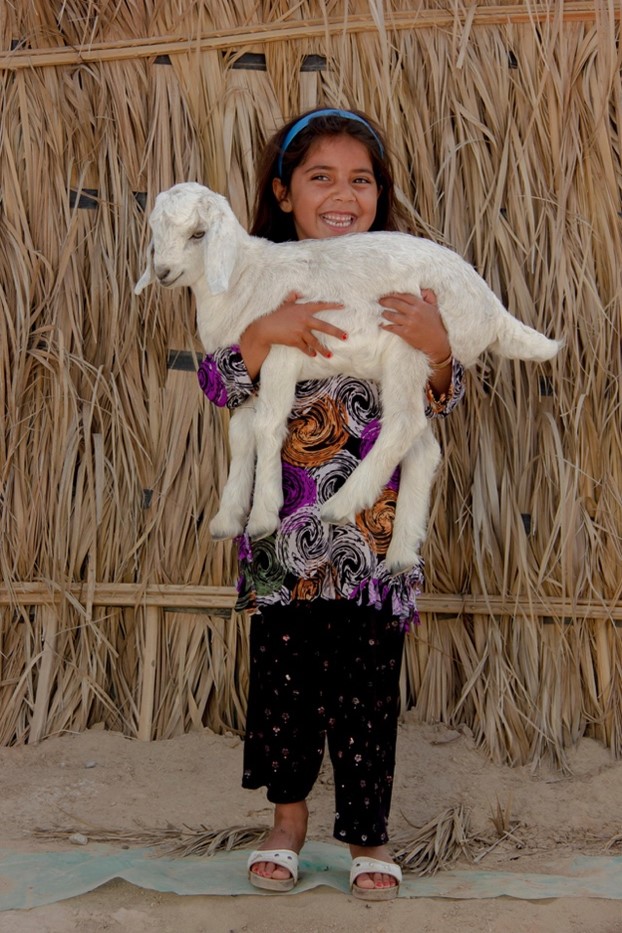
A young girl holds a small white lamb in front of a woven straw backdrop, showcasing the connection between pastoral life and the materials used in a Persian Style Rug. Photo by Mostafa Meraji
Young lambs provide the softest wool, perfect for delicate designs like prayer rugs. This wool, sometimes combed in winter, feels smooth and flexible. In contrast, wool from older sheep is tougher but still useful for larger, durable rugs.
Goat hair adds another layer of texture to a Persian Style Rug. In some regions, artisans use the soft down from goats to create a plush feel. The straight hair, often light brown, works well for natural brown backgrounds since it doesn’t take dye easily.
This goat hair also forms sturdy edges and fringes in some rugs. However, it can have a strong smell when wet because it’s not always washed before weaving. The hair curls tightly when damp, making it hard to spin, but it adds a rustic charm.
Camel hair brings a silky softness to certain Persian Style Rugs. Camels in some areas grow long, woolly hair that artisans never dye, keeping its natural sheen. This hair is more costly than sheep’s wool but lasts a long time, making it ideal for rugs that endure heavy use.
Cotton often forms the rug’s foundation, providing a strong base for the pile. Silk, used in a Silk Persian Rug, adds a glossy shine and fine detail to patterns. These materials are carefully prepared before weaving begins.
Artisans wash the fibers to remove dirt and oils, often using soft water for better results. They might bleach the fibers in the sun, then pound them with wooden tools to soften them further. After washing again in running water, the fibers dry under the sun, shrinking significantly but gaining a refined texture.
Dyes bring the colors to life, made from plants, insects, or minerals. Think deep reds from madder root, soft blues from indigo, or earthy greens from walnut shells. Artisans dye fibers in small batches for even color, using recipes handed down through families.
This preparation ensures the rug’s hues stay bright for decades. They might soak silk in indigo for a rich blue shade. Or they boil madder root for a warm red tone that lasts.
Here’s a quick look at the materials used in a Persian Style Rug.
Table: Materials Used in Traditional Persian Style Rugs
| Material | Purpose | Common Source |
| Wool | Main pile material | Sheep |
| Goat Hair | Adds texture, edges | Goats |
| Camel Hair | Silky, durable pile | Camels |
| Cotton | Forms the foundation | Cotton plants |
| Silk | Adds shine and detail | Silkworms |
Caption: This table shows the building blocks of a rug’s beauty. Each material adds to the final design, mixing strength with elegance.
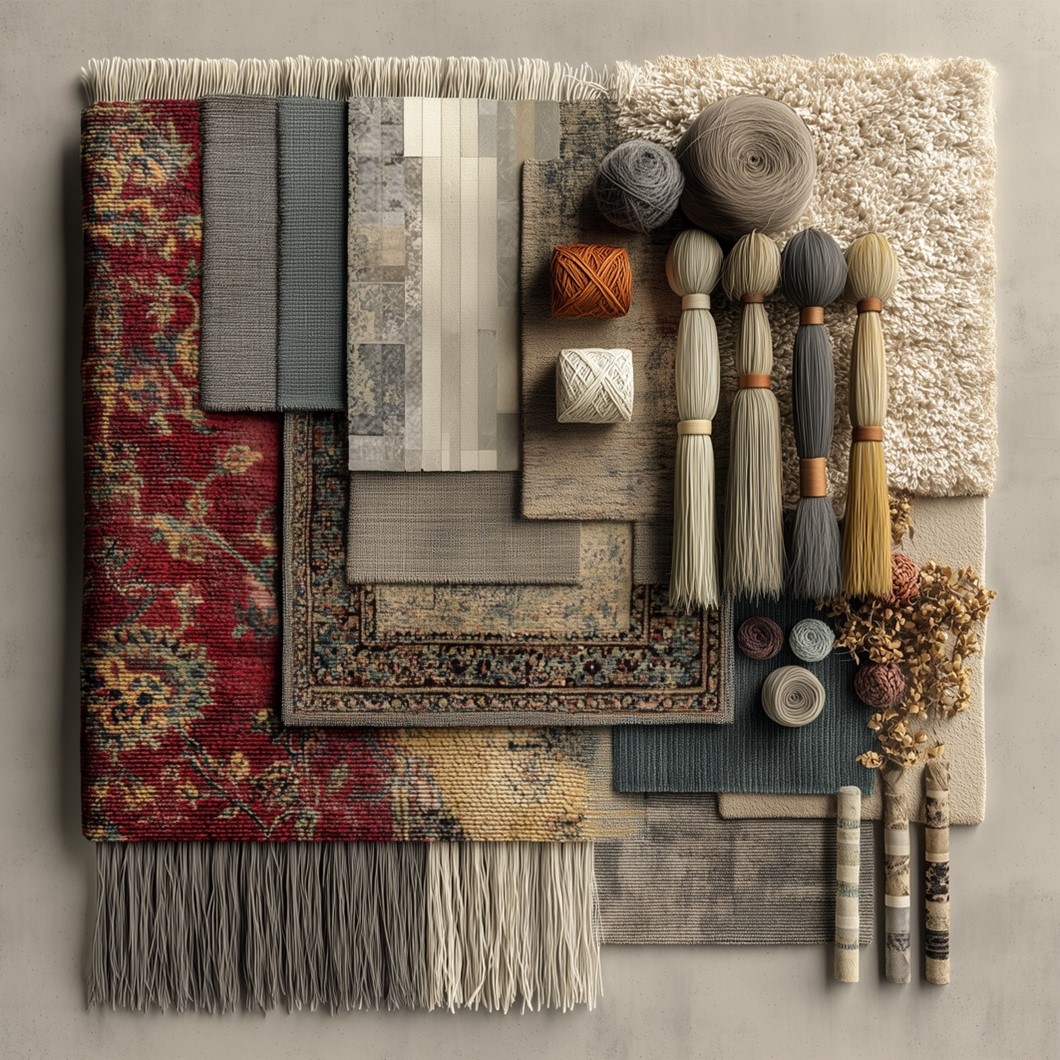
A mood board showing the materials of a Persian Style Rug, with colorful threads, tassels, and a red rug sample. Image courtesy of Afra Rugs.
The Weaving Process of Persian Rugs
The heart of how Persian Rugs are made lies in the weaving. Artisans set up a loom—a wooden frame that holds the warp threads tight. They weave the weft threads across the warp to create the rug’s base.
Next, they tie tiny knots to form the pile, which makes the rug soft. The Persian knot, an uneven knot, lets them craft detailed patterns. A skilled weaver ties thousands of knots daily, working row by row to build the design.
For a Silk Persian Rug, the knots are even smaller, giving a smooth, glossy finish. A talented weaver delegate can tie up to 14 knots per minute, which adds up to around 8,000 knots in a day. This speed shows the skill and patience needed for each rug.
Weavers often work from sunrise to sunset, creating rugs as both a craft and a source of income. Many start as young apprentices, learning the trade over years. They take pride in their work, hoping their rugs might one day earn recognition for their beauty.
In some regions, a head weaver leads the team, overseeing the design and quality. They might sing the pattern aloud, guiding the others as they work. This tradition keeps the design alive, even without written plans, as patterns are often memorized or drawn in the sand.
The warp threads are spun tightly for strength, while the pile yarn is kept loose and thick for a soft feel. More weft threads between rows of knots make the rug shinier, as the pile can untwist and catch the light. Fewer weft threads make the rug more flexible, perfect for laying flat on the floor.
Here are the main steps in weaving a Silk Persian Rug:
- Set up the loom: Artisans stretch the warp threads tight.
- Tie the knots: Each knot shapes the pattern.
- Weave the weft: This locks the knots in place.
- Trim the pile: Artisans smooth the surface for a soft feel.
This careful process ensures every rug is a work of art. The time invested makes each piece truly special.
Finishing Touches and Cultural Significance
After weaving, artisans refine the Persian Style Rug with finishing touches. They trim the pile to make it smooth and even. Some wash the rug with water or herbal solutions to soften fibers and boost colors.
Artisans add tassels or fringes to the edges for a polished look. These details give the rug its final charm. A well-finished rug feels complete, ready to adorn any space.
Dyes play a big role in the rug’s final look, and their creation is an art form. “The secrets of the Eastern dye-pot are responsible for the unrivalled beauty and durability of the Oriental rug” (Forgotten Books, 2016, p. 75). Artisans use natural ingredients like roots, leaves, and even insects to create lasting colors.
Red, a favorite in many rugs, comes from sources like madder root or dried insects, offering shades from soft pink to deep scarlet. Blue often starts with indigo, mixed with other dyes for hues like violet or porcelain blue. Some ancient blues have been lost to time, their recipes forgotten.
Colors carry meaning in a Persian Style Rug. Red stands for joy and sincerity, while green, a sacred color, often appears in prayer rugs to symbolize immortality. Blue might represent the sky, and white can signal mourning in some traditions.
Prayer rugs hold special significance, often featuring a niche design that points toward a holy direction. Some include a pitcher symbol, reminding the owner to wash before prayer—a key ritual. These rugs aren’t just for decoration; they’re tools for spiritual connection.
Different regions prefer certain colors. Persians love deep greens and yellows, while Turks favor reds. In areas with bright sunlight, bold colors like red and blue stand out, while neutral tones are less common. These preferences reflect the land and culture around them.
A Persian Style Rug holds deep cultural meaning. These rugs often feature symbols—flowers for growth, stars for protection—woven into their designs. They’ve graced homes, palaces, and ceremonies, symbolizing beauty and heritage.
Here’s a visual summary of the process.
Infographic: The Journey of a Persian Style Rug

This infographic shows the steps of how Persian Rugs are made, from dyeing fibers to tying knots. It includes four stages: material preparation, loom setup, knotting, and finishing touches, with icons for each step. Infographic by Afra Rugs.
Caring for Your Persian Rug
Keep your Persian Style Rug looking fresh with simple care steps. Vacuum it gently to remove dust, but avoid strong settings that might pull fibers. If you spill something, blot the spot with a damp cloth—don’t rub, as it can spread the stain.
Rotate the rug every few months for even wear. For a thorough clean, use professional services every few years. This keeps colors bright, like in a Red Persian Rug.
Avoid placing the rug in direct sunlight for long periods—it can fade the colors over time. Use a rug pad underneath to prevent slipping and add cushioning. If the rug feels stiff, gently shake it to loosen the fibers.
For rugs with natural dyes, be cautious with water, as some fibers like goat hair can curl or smell when wet. Instead, spot-clean with a dry cloth first. If the rug has fringes, comb them gently to prevent tangling.
Store the rug rolled, not folded, to avoid creases. Wrap it in a breathable cloth to protect it from dust and pests. With these steps, your rug can stay beautiful for years.
FAQ: How Persian Rugs Are Made?
- What makes a Persian Style Rug so special?
A Persian Style Rug stands out for its intricate patterns and cultural depth. It reflects centuries of weaving traditions.
- How long does it take to make a Silk Persian Rug?
A Silk Persian Rug can take months or even years. It depends on the size and design complexity.
- Why are the colors in a Red Persian Rug so vibrant?
The colors in a Red Persian Rug come from natural dyes, like madder root. They create rich, lasting hues.
- Can I use a Persian Style Rug in any room?
Yes, a Persian Style Rug adds warmth and elegance everywhere. It’s perfect for living rooms or bedrooms.
- How can I tell if a rug is a true Persian Style Rug?
Look for detailed patterns and a soft pile. These are hallmarks of a Persian Style Rug with traditional roots.
Conclusion: How Persian Rugs Are Made?
Artisans beautifully blend art and tradition in the process of making Persian Rugs. Artisans dye fibers, tie knots, and add finishing touches with deep respect for their craft.
A Silk Persian Rug shines, while a Red Persian Rug feels warm. Both bring history to your home. At Afra Rugs, we’re inspired by this legacy. Explore our Traditional Persian Rugs Collection to find a rug that tells your story.

